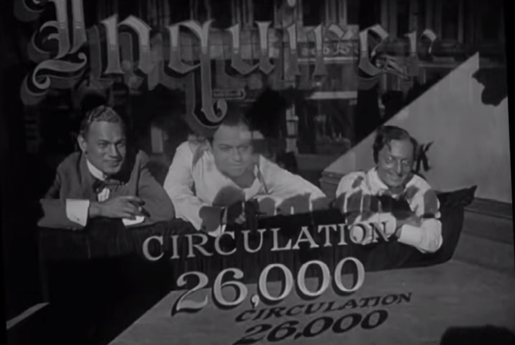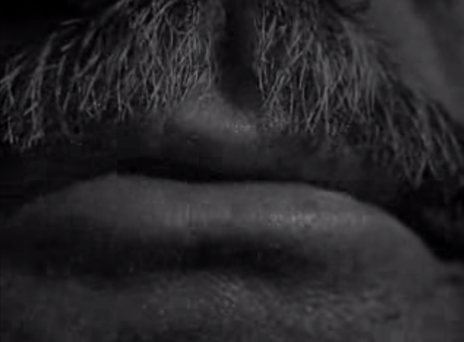
I must admit to committing an unforgivable fallacy. Maybe I’m the only perpetrator, but there might be others too. In my own mental computations, I often attribute Jane Wyman as the first wife of Ronald Reagan more than I equate her with her acting career. And though Nancy Davis hardly built such a substantial Hollywood career, I am quick to remember her because she was, after all, the First Lady.
However, with viewings of the Yearling and especially Johnny Belinda, I hoped to remedy this by recalibrating my brain’s gut responses. It was a stunning success. I’ve never been more mesmerized with Jane Wyman, and the core of Johnny Belinda’s merit lies in how simple it is. She does so very much with so little and in a medium often hampered by excess, Johnny Belinda is, in its finest moments, a quietly moving examination of a human being.
Cape Breton can be easily placed. There’s a wharf and a cannery. Men work at sea bringing in the days catch, and there’s nothing glamorous about their existence. The work is hard and the people blue collar. It’s the wrong coast, but these are the kindred of Steinbeck and certainly, you cannot help but think of Fritz Lang’s Clash by Night with its seascape and gale of drama.
However, I happen to think Johnny Belinda weathers the drama with a more delicate touch. We must turn to the characters to understand how this really happens. Because the small-town setting is stocked up with all types and shades of people. An amiable doctor named Richardson (Lew Ayres) has recently set up practice on the island making housecalls aided by a pleasant bedside manner. His swooning young housekeeper (an oft-forgotten Jan Sterling) is smitten and wishes above anything to be noticed.
It’s true he’s both a generous and obliging fellow though he doesn’t go to church on Sundays. It’s one reason for the old ladies in town to still somehow doubt his sincerity. He certainly can’t be familiar with “Christian charity” as they are!
Aside from the run-of-the-mill gossips, there’s the slimy reprobate Locky McCormick (Stephen McNally). Presently we might label him rightly as a bastion of toxic masculinity. However, the bottom line is he’s a vain and destructive human being who is able to fly under the radar due to the town’s hypocrisy. In other words, he goes to church on Sundays and manages to be romantically linked to the aforementioned housekeeper Stella.
We must also mention the gruff but not unkind farmer Black MacDonald (Charles Bickford). In fact, over time, he starts looking better and better as his work ethic and old-fashioned decency begin to let slide his affection for his daughter (Wyman). Meanwhile, his sister is played by Agnes Moorehead, a criminally underrated actress, perhaps because people do not superficially tout her looks. And yet she is a remarkable performer bringing strength and an acerbic edge to her part.
Even with these people, the spokes of a story aren’t altogether obvious as the kindly doctor takes the dumb and mute young woman under his tutelage, perceiving her intelligence and the dormant curiosity inside of her.
Wyman models her transformation exquisitely, first, picking up signing, then learning basic gestures of communication. However, in a town like this, there are certain types of ignorant people. People who will only ever see her as a “dummy.” There is no beauty or intelligence to unlocked inside her countenance because they can only comprehend the physical.
One prime example is when some merrymakers have an impromptu shindig at MacDonald’s barn fater picking up their weekly order of flour. The good doctor stands by Belinda beaming, showing her a fiddler plucking away joyously on his strings. The discovery is manifested on her face as she touches the violin with its vibrating strings and her feet begin to patter modestly. Her legs move tentatively but sweetly as if unshackled for the first time.
Others see it too. First, Locky his eyes burning with lust and then his jealous girlfriend trying to win back his affection with a carnal kiss. These are the only things they know about passion and romance. Add alcohol to the mix and it’s a volatile cocktail.
The film’s most helplessly terrifying moment comes when the belligerent thug wanders off from the party and finds a peaceful Belinda. His eyes burn with malicious intent. She has only innocence which quickly turn to fear as he encroaches. The subsequent inference of images and cuts speak for themselves as do ensuing events…

Recently I’ve been pushing back against the era’s tendency toward over-illumination when it comes to spelling information out. However, some of the greats, Hitchcock and Lang among them, were able to imbue sound films with a certain silent sensibility where passages rely on the primacy of image over sound.
I won’t put Jean Negulesco in the same group as these others, but nevertheless, his premise necessitates a certain amount of nuance in order to approach the subject matter. It’s a tact that I very much appreciate because the film ably takes on the restraint and the functionality of a silent film especially when considering the subject of Belinda.
Consider, for example, a near-wordless entrance into the church with the stunned congregation looking on as a lovely Belinda enters in her Sunday best. In the same sequence, Dr. Richardson watches Belinda’s face swell with apprehension upon seeing McCormick for the first time. The power comes in this unspoken revelation.
The story must progress, and it evolves into a modern play on The Scarlet Letter with pernicious scandal digging in. You must remember this is the same small town with ears and eyes on every street corner. News travels fast that Belinda has a child and everyone has their preconceived notions on who the father is. They are intent on taking matters into their own hands. I need not expound upon this anymore.
More useful still are the impressions of the following scenes. In a strikingly poignant interlude, Belinda signs “The Lord’s Prayer” as the solemn bystanders join her in grieving the dead. We are reminded this is a different era imprinted with Christianity and a God who was a present comfort in the face of adversity.
Her moments taking care of her baby are also so tender and one is reminded of the universal experience of parenthood. Belinda might not be able to speak or hear but she feels and becomes both guardian and protectorate of that little bundle of joy no matter the cost.
An ensuing trial has her in the defendant’s seat and these scenes are generally conventional. They crop up in any amount of noir, melodrama, screwball comedy, whatever. It’s the precise circumstances that make it an engaging end. Because court is all about testimony and defense. What if someone is barely able to defend themselves?
They require others to intercede on their behalf. The final safety valve providing the audience a release is overblown and a foregone conclusion, but up to this point, what a joy it is to watch events unfold moment after moment.
This is a fine turn by late-period Lew Ayres although he is nothing without the quiet dignity and sprightly inquisitiveness of Jane Wyman. Johnny Belinda is a stunning reminder truth need not only come in the powerful wind or the quiet whisper. It can come in silence as well.
4/5 Stars




 Are you always drawn to the loveless and unfriended? ~ Edward Rochester
Are you always drawn to the loveless and unfriended? ~ Edward Rochester




